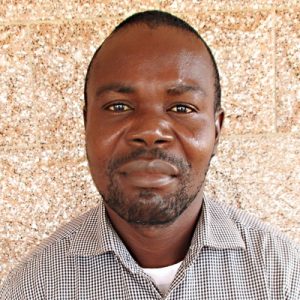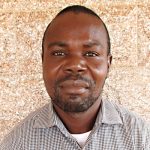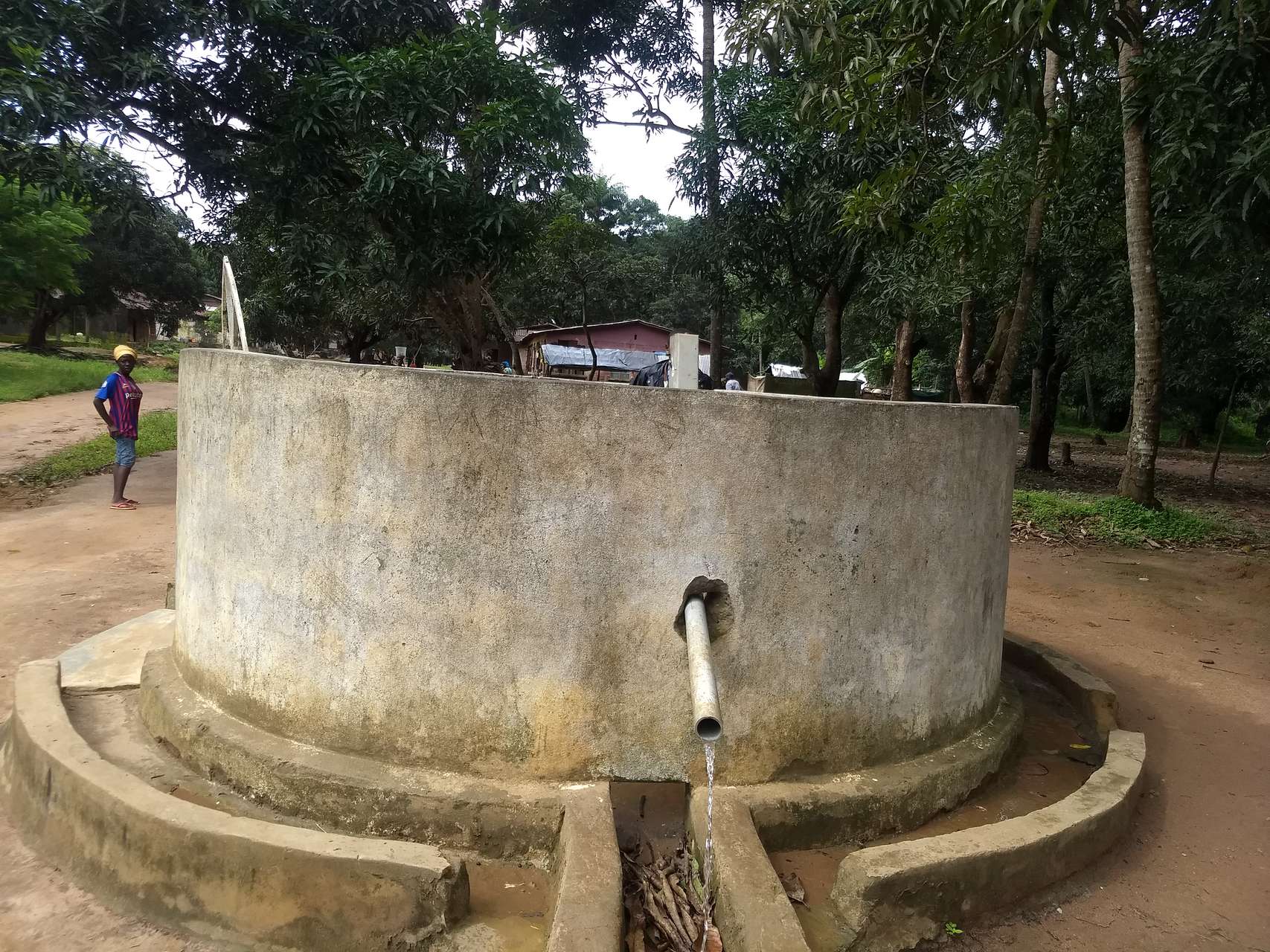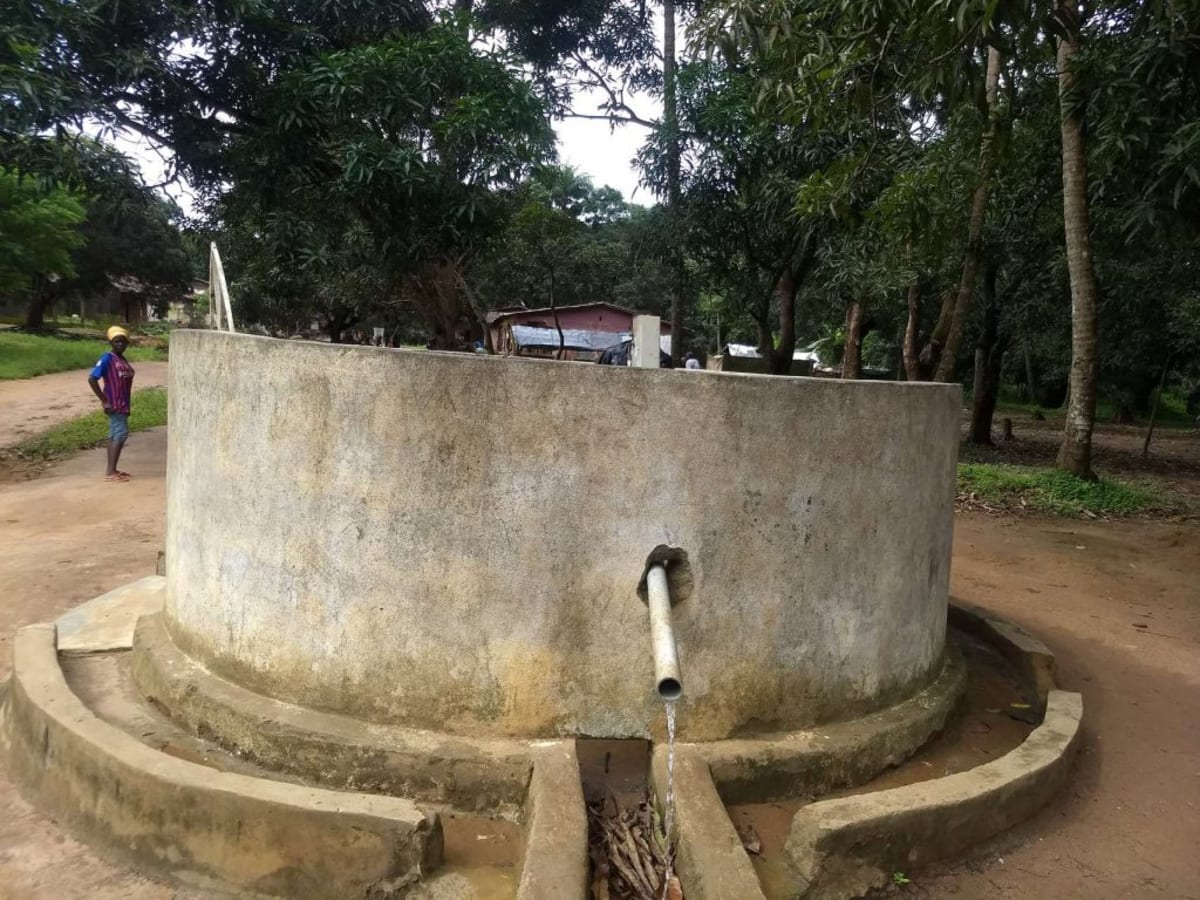January, 2019: Mondor Community Project Complete
We are excited to share that there is safe, reliable water in Mondor Community, which is already providing clean water to families! People here no longer have to rely on dirty water from the swamp.
Clean Water Restored
The team of three artisans set up their camping gear near the water point and performed the necessary checks on equipment to get them ready for the next day’s operation. The proceeded to rehabilitate the existing well.

A mother gives water from the well to her daughter.
This is how it was done:
Socketing the pipes
Because the sizes of the original sockets are not always appropriate, fire is set to heat pipes that to be used to improvise sockets. The heated pipe fits into the other pipe so that it further opens to create an improvised socket.
Fixing the tripod
Three metal pipes are connected to make a single pod, there are nine of those needed for a tripod. A rope is then passed through a pulley attached to the top end of the tripod. This rope is tied to the bucket auger drill bit to the drilling rod and lowered inside the temporary casing to the bottom of the well.
Finding depth
After the installation of the tripod, the static level and total depth are established. For these levels, the team uses a drop line that has a metal tied to one end. This line is dropped into the well and tied at the frame of the well to indicate the total depth of the well. The tied portion of the line to the watermark is the static level. If you subtract the static level from the total depth, you get the water quantity.
Installation of casing pipes
A 6″ casing pipe is fitted into an iron plank and riveted for a firm grip. A nut is then slacked from the plank and a rope tied to the 6″ socket is pulled to allow the pulley to easily lower the pipe into the well. A strong board is laid on top of the pipe and forcefully hit to let it sit tight at the base of the well.

Lining up the drilling rod
These rods are numbered and connected accordingly. A rope is tied to the end of the last rod which will be pulled and released instantaneously so that the drilling bits will dig a borehole into the soil down the well.
Drilling
The team offered prayers and this was led by an artisan, Raymon and Thaimu. After that, they fixed the sand bit and drilled through sand layer for about fourteen feet, increasing the total depth to seventy-three feet.

Screening
The 4″ casing pipes are laid out to the requisite depth of the well after reaching a total of 84 feet. The casing pipes are the screened, that is, the pipes are given slight slices to make a passage for water. The pipe is then wrapped with empty rice bags all in the bid to help filter any debris.
This screened pipe is slotted into casing pipes and is lowered into the well. About 5 buckets of sand mixed with small stones, called filter packs, is poured in between the two casings. A chain hoist is set up to pull out the temporary casing, leaving the 4′ pipe at the bottom of the well.
Iron rod support
This process requires that the iron rod is cemented to the well lining and attached to the casing to support the weight of the PVC and keep it straight from the bottom of the well to the top of the pump base. They weld a collar into the pump base to help support the casing.
Bailing and Yield testing
The hand bailing system requires two people to bail by hand. A well is bailed for three days. The well is then yield tested by installing an electrical submersible pump to the depth of the well and is pumped for about an hour. They continue pumping for another hour while measuring the amount of water pumped out. They were relieved after the yield test. After passing the yield test, a sanitary seal is placed in the borehole to about three feet from the surface with cement to keep it clean.

Padding
This involves constructing a cement wall around the well and constructing a drainage system for the control of unwanted water around the well area. This process takes three days to complete.
Installation
A quality stainless steel India MKII hand-pump was then installed. The pump’s cylinder is installed to a depth similar to that of the yield test.

Dedication
The dedication is all about handing the water well facility over to the community. A cross-section of the office staff went to organize a ceremony where community members were given final instructions about the benefit of safe drinking water and proper care of the pump.

Although we are currently in the rainy season, this dedication happened under a very favorable atmosphere, with the rain wreaking no havoc. When the team arrived in the community, the headman and many other community people were already at the water point waiting for the team. This is the result of good planning. However, the chief released some other person to make the entire community learn about the team’s arrival for the occasion.
The people came by dancing to the song from the team’s boombox. Men and women, young and old, all came by dancing and giving praises to God for the opportunity. They all converged at the water point with smiles all over their faces. The dancing continued while the team was busy putting their act together.
Fatama Bangura was given the opportunity to make a statement. She thanked the donors and the organization that shared such a wonderful spirit with her community.
"This well has freed us from the grips of the constant threats from cholera and diarrhea during the rainy season," she said.
"Our kids no longer have to spend hours at the swamp only to supply water for home use."
New Knowledge
The team coordinator, Zainab, called her team together to go through the information collected during a visit and interviews in Mondor Community.
On the first morning of hygiene and sanitation training, the last call was made to the headman to alert him that we were on our way. When the team finally arrived in this community, all that was needed was to consult with some community elders, who then sent a community member to make a brief alarm about the team's presence. More than 100 people came to attend the event.

Mondor is a very vegetated community and training can be held everywhere without any hindrance from the sun. And this training was held under very shaded mango trees from across the street of the chief’s compound. The place was spacious and could almost accommodate the whole community. The shades from the mango trees prevented any threats from the heat of the sun. In fact, the gentle breeze under the trees tempted some participants to sleep had the instructors not mastered their topics and aroused the people’s interest in their presentations.
The people were not only there to participate, but they were fully involved in whatever was going on during training.

Topics covered included:
- Hand Washing
- Tippy Tap
- Good and Bad Hygiene
- Healthy and Unhealthy community
- Animal Houses
- Dish Racks and Clotheslines
- Food Science
- Disease Transmission
- Proper care of the pump

"I was very unfortunate not to be around for the first day of training, but what I learned from yesterday and today will help me avoid most of the diseases that plague us in this community," said Hassan Mansaray.
"The lesson from tooth care is what benefit from the most because I normally have issues with my teeth."



 Protected Dug Well
Protected Dug Well































